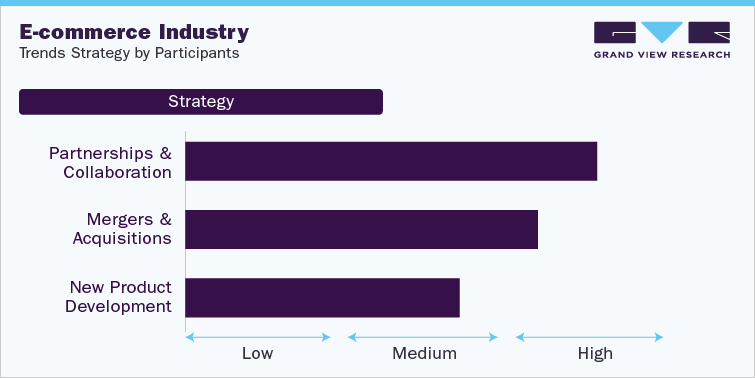
E-commerce industry data book covers B2B E-commerce and B2C E-commerce market. The global E-commerce market was valued at USD 13,497.0 billion in 2022 and is projected to grow at a CAGR of 15.0% from 2023 to 2030.
Grand View Research’s E-commerce industry databook is a collection of market sizing information & forecasts, competitive benchmarking analyses, macro-environmental analyses, and regulatory & technological framework studies. Within the purview of the database, all such information is systematically analyzed and provided in the form of presentations and detailed outlook reports on individual areas of research.
Access the Global E-commerce Industry Data Book from 2023 to 2030, compiled with details by Grand View Research
B2B E-commerce Market Growth & Trends
The global B2B e-commerce market was valued at USD 7,904.0 billion in 2022 and is projected to grow at a CAGR of 22.8% from 2023 to 2030, according to a new study by Grand View Research Inc. Technologies enabling the adoption of B2B e-commerce platforms are favoring the market growth. For instance, the proliferation of 5G and smartphones worldwide is expected to be a key growth driver for the market. Moreover, the COVID-19 pandemic has resulted in an increased acceptance of B2B e-commerce among end-users. Companies across the globe are focused on adopting a mixed-channel strategy with an emphasis on online channels to drive revenue.
In addition to the demand generated for online e-commerce amidst the pandemic, proactive government support, such as tax waiver, improved transport infrastructure, and reforms supporting excise/customs duty, is also expected to support business to business e-commerce market growth. Moreover, various laws have been reinforced to protect data privacy for both consumers and businesses, such as the law drafted in California, U.S. Such initiatives are likely to improve online trade penetration.
The market is also expected to experience numerous growth opportunities due to the increasing benefits of technologies such as AR, VR, and AI in influencing consumer purchase decisions. The deployment of such technologies helps vendors to enhance the user experience while offering detailed product information in an interactive format. While chatbots have already made their way into the e-commerce market, technologies such as voice commerce are expected to further boost business to business e-commerce market growth.
The COVID-19 outbreak has created unique challenges in most sectors, including business-to-business e-commerce. Businesses changed their business models as supply chains faced a bipolar effect of either excess inventory or shortage of inventory. Moreover, the aftereffects of the pandemic, such as salary cuts, minimized disposable incomes, and loss of jobs, have resulted in reduced spending by promising customers. To overcome these challenges, B2B businesses have shifted their focus to new online strategies, thus contributing to the transformation of the B2B e-commerce industry.
Order your copy of Free Sample of “E-commerce Industry Data Book –Market Size, Share, Trends Analysis And Segment Forecasts, 2023 - 2030” Data Book, published by Grand View Research
B2C E-commerce Market Growth & Trends
The B2C service segment of the e-commerce market by model type was estimated to be USD 4,398.9 billion in 2022 and is expected to have a CAGR of 9.7% during the forecast period 2023-2030, according to a new report by Grand View Research, Inc. It is expected to expand at a CAGR of 9.7% over the forecast period. The increasing disposable income level, escalating usage of internet and smartphones, and an increasing number of online shoppers are expected to drive the market growth. Online goods and service providers offer various options to their customers, such as vast product portfolio, discounted price rates, convenient payment methods, same-day delivery, and easy return policies while purchasing any goods or services, resulting in growing customer preference toward e-commerce platforms.
The General Agreement on Trade in Services (GATS) provides the rules and regulations governing international trade in services, with significant implications for e-commerce. The anti-Spam Law is placed to protect consumers from receiving unsolicited marketing material. Although online businesses collect information from consumers, they are legally prohibited to spam people's inboxes without their consent. Technological advancement supported by increasing usage of Artificial Intelligence (AI) is providing customers with a real-time shopping experience. For instance, Augmented Reality (AR) technology offers customers ‘virtual changing rooms’ wherein customers can try a product virtually.
The rapid evolution of e-commerce has brought numerous opportunities to both nascent as well as established players in the market. However, online payment processes have witnessed few challenges in the recent past. The interconnected and instantaneous nature of online payment channels has increased vulnerability towards cybercrime, digital frauds, and other malpractices. To overcome these cybersecurity concerns, it is essential to emphasize service security and the protection of consumer’s data.
Go through the table of content of E-commerce Industry Data Book to get a better understanding of the Coverage & Scope of the study.
Competitive Landscape
Key players operating in the E-commerce Industry are –
• Alibaba Group Holding Limited
• Amazon.com, Inc.
• Apple Inc.
• Best Buy
• eBay Inc.
• Shopify Inc.
No comments:
Post a Comment